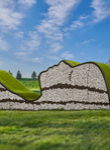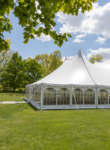Adams (Malus ‘Adams’):
20 feet high and 20 feet wide; rounded form; rose colored flowers; dark red, persistent fruit. Disease resistance: scab (fair), fireblight (excellent), rust (fair), mildew (fair).
Adirondack (Malus ‘Adirondack’):
12 to 18 feet high and 6 to 10 feet wide; narrow, upright form; white flowers; orange red fruit. Disease resistance: scab (excellent), fireblight (excellent), rust (excellent), mildew (excellent).
Beverly (Malus ‘Beverly’):
20 feet high and 20 feet wide; rounded form; white flowers, red fruit. Disease resistance: scab (excellent), fireblight (fair), rust (excellent), mildew (excellent).
Cardinal (Malus ‘Cardinal’):
15 to 18 feet high and 20 feet wide; upright spreading; dark purple-red foliage; magenta-pink flowers; deep red fruit. Disease resistance: scab excellent), fire blight (good), rust (excellent), mildew (excellent).
Centurion® (Malus ‘Centzam’):
15 to 20 feet high and 15 feet wide; narrow, upright form; red flowers; cherry red, persistent fruit. Disease resistance: scab (fair), fireblight (excellent), rust (excellent), mildew (excellent).
Coralburst® (Malus ‘Coralcole’):
10 feet high and 10 to 15 feet wide; rounded form; rose colored flowers; bronze-yellow fruit. Disease resistance: scab (fair), fireblight (excellent), rust (excellent), mildew (excellent).
David (Malus ‘David’):
15 feet high and 15 feet wide; rounded form; white flowers; scarlet red, persistent fruit. Disease resistance: scab (good), fireblight (good), rust (excellent), mildew (excellent).
Dolgo (Malus ‘Dolgo’):
40 feet high and 30 feet wide; upright, spreading form; white flowers; reddish purple fruit. Disease resistance: scab (excellent), fireblight (good), rust (excellent), mildew (excellent).
Donald Wyman (Malus ‘Donald Wyman’):
20 feet high and 20 feet wide; rounded form; white flowers; red, persistent fruit. Disease resistance: scab (good), fireblight (excellent), rust (excellent), mildew (good).
Doubloons (Malus ‘Doubloons’):
12 feet high and 10 feet wide; rounded form; white flowers; yellow-gold fruit. Disease resistance: scab (poor), fireblight (excellent), rust (excellent), mildew (excellent).
Golden Raindrops® (Malus ‘Schmidtcultleaf’):
20 feet high and 15 feet wide; upright, vase-shaped; deeply cut green leaves; white flowers; small yellow fruit. Disease resistance: scab (excellent), fire blight (good), rust (excellent), mildew (excellent).
Harvest Gold® (Malus ‘Hargozam’):
20 feet high and 15 feet wide; upright form; white flowers; golden yellow fruit. Disease resistance: scab (excellent), fire blight (fair), rust (excellent), mildew (excellent).
Indian Magic (Malus ‘Indian Magic’):
20 feet high and 15 feet wide; rounded form; rose pink flowers; red, persistent fruit. Disease resistance: scab (poor), fire blight (fair), rust (excellent), mildew (excellent).
Indian Summer (Malus ‘Indian Summer’):
18 feet high and 20 feet wide; rounded form; rose red flowers; red, persistent fruit. Disease resistance: scab (fair), fire blight (excellent), rust (excellent), mildew (excellent).
Lancelot (Malus x ‘Lanzam’):
8 to 10 feet and wide; rounded form; white flowers; persistent gold fruit. Disease resistance : scab (excellent), fire blight (excellent), rust (excellent), mildew (excellent).
Lollipop® (Malus ‘Lollizam’):
10 to 12 feet high and wide; compact, rounded form; white flowers; yellow fruit Disease resistance: scab (excellent), fire blight (excellent), rust (excellent), mildew (excellent).
Louisa (Malus ‘Louisa’):
8 to 12 feet high and 15 feet wide; weeping form; pink flowers; yellow fruit. Disease resistance: scab (fair), fire blight (good), rust (good), mildew (excellent).
Molten Lava® (Malus ‘Molazam’):
12 feet high and 15 feet wide; broad weeping form; white flowers; orange red, persistent flowers. Disease resistance: scab (excellent), fire blight (excellent), rust (fair), mildew (excellent).
Pink Princess™ (Malus ‘Parrisi’):
8 feet high and 12 feet wide; low spreading form; rose pink flowers; dark red fruit. Disease resistance: scab (fair), fire blight (fair), rust (fair), mildew (fair).
Prairifire (Malus ‘Prairifire):
20 feet high and 20 feet wide; upright, rounded form; dark red flowers; purplish-red fruit. Disease resistance: scab (excellent), fire blight (excellent), rust (excellent), mildew (excellent).
Professor Sprenger (Malus ‘Professor Sprenger’):
20 feet high and 20 feet wide; upright spreading form; white flowers; orange red, persistent fruit. Disease resistance: scab (excellent), fire blight (excellent), rust (excellent), mildew (excellent).
Profusion (Malus ‘Profusion’):
20 feet high and 20 feet wide; upright, spreading form; rose pink flowers; dark red, persistent fruit. Disease resistance: scab (fair), fire blight (fair), rust (excellent), mildew (good).
Purple Prince (Malus ‘Purple Prince’):
18 to 20 feet high and wide; rounded form; rose red flowers; maroon fruit. Disease resistance: scab (good), fire blight (good), rust (excellent), mildew (excellent).
Radiant (Malus ‘Radiant’):
25 feet high and 20 feet wide; rounded form; dark pink flowers; red/yellow fruit. Disease resistance: scab (poor), fire blight (excellent), rust (good), mildew (fair).
Red Jade (Malus ‘Red Jade’):
12 feet high and 20 feet wide; weeping form; white flowers; red, persistent fruit. Disease resistance: scab (poor), fire blight (fair), rust (fair), mildew (fair).
Red Jewel™ (Malus ‘Jewelcole’):
18 feet high and 12 feet wide; upright, rounded form; white flowers; cherry red, persistent fruit. Disease resistance: scab (good), fire blight (poor), rust (excellent), mildew (good).
Red Splendor (Malus ‘Red Splendor’):
20 feet high and 20 feet wide; upright, rounded form; pink flowers; red, persistent fruit. Disease resistance: scab (poor), fire blight (fair), rust (good), mildew (fair).
Robinson (Malus ‘Robinson’):
25 feet high and 25 feet wide; upright, spreading form; pink flowers; dark red, persistent fruit. Disease resistance: scab (fair), fire blight (good), rust (good), mildew (good)
Royal Raindrops® (Malus x ‘JFS-KW5’):
15 to 20 feet high and wide; rounded form; pink flowers; maroon-red, persistent fruit. Disease resistance: scab (excellent), fire blight (good), rust (good), mildew (good).
Royalty (Malus ‘Royalty’):
20 feet high and 15 feet wide; upright, rounded form; crimson purple flowers; red purple fruit. Disease resistance: scab (poor), fire blight (poor), rust (good), mildew (fair).
Ruby Tears™ (Malus ‘Bailears’):
8 to 10 feet high and 12 to 15 feet wide; weeping form;burgundy-green foliage; pink flowers; red fruit. Disease resistance: scab (excellent), fire blight (excellent); rust (excellent); mildew (excellent).
Sargent Crab (Malus sargentii):
A species crabapple. 8 to 10 feet high and 10 to 12 feet wide; spreading dwarf form; red buds turn to white flowers; red persistent fruit Disease resistance: scab (excellent), fire blight (excellent), rust (excellent); mildew (excellent).
Sargent Crab Candymint (Malus ‘Candymint’):
10 feet high and 18 feet wide, spreading habit, pink with a redeye, red fruit. Disease resistance: scab (excellent), fire blight (excellent), rust (excellent), mildew (excellent).
Showtime™ (Malus ‘Shotizam’):
20 feet high and wide; broadly oval to rounded form; purple green foliage; pinkish red flowers; red fruit. Disease resistance: scab (fair), fire blight (good), rust (good), mildew (excellent).
Silver Moon (Malus ‘Silver Moon’):
20 feet high and 15 feet wide; upright, rounded form; white flowers; dark red fruit. Disease resistance: scab (poor), fire blight (poor), rust (poor), mildew (poor).
Snowdrift (Malus ‘Snowdrift’):
20 feet high and 20 feet wide; rounded form; white flowers; orange red, persistent fruit. Disease resistance: scab (poor), fire blight (poor), rust (good), mildew (good).
Spring Snow (Malus ‘Spring Snow’):
25 feet high and 20 feet wide; upright, oval form; white flowers; nearly sterile (little to no fruit). Disease resistance: scab (fair), fire blight (fair), rust (good), mildew (good).
Sugar Tyme® (Malus ‘Sutyzam’):
18 feet high and 15 feet wide; upright, spreading form; white flowers; red, persistent fruit. Disease resistance: scab (excellent), fire blight (good), rust (good), mildew (good).
Tina crabapple (Malus sargentii ‘Tina’):
5 to 6 feet high and 6 to 8 feet wide; spreading dwarf habit,; red buds open white; red fruit Disease resistance: scab (excellent), fire blight (good), rust (excellent), mildew (excellent).
Velvet Pillar™ (Malus ‘Velvetcole’):
20 feet high and 14 feet wide; narrow, upright form; pink flowers; red fruit. Disease resistance: scab (poor), fire blight (fair), rust (fair), mildew (fair).
Zumi Calocarpa (Malus x zumi ‘Calocarpa’):
20 to 25 feet high and wide; upright spreading form; white flowers; bright red, persistent fruit. Disease resistance: scab (excellent), fire blight (poor), rust (good), mildew (good).

























































































